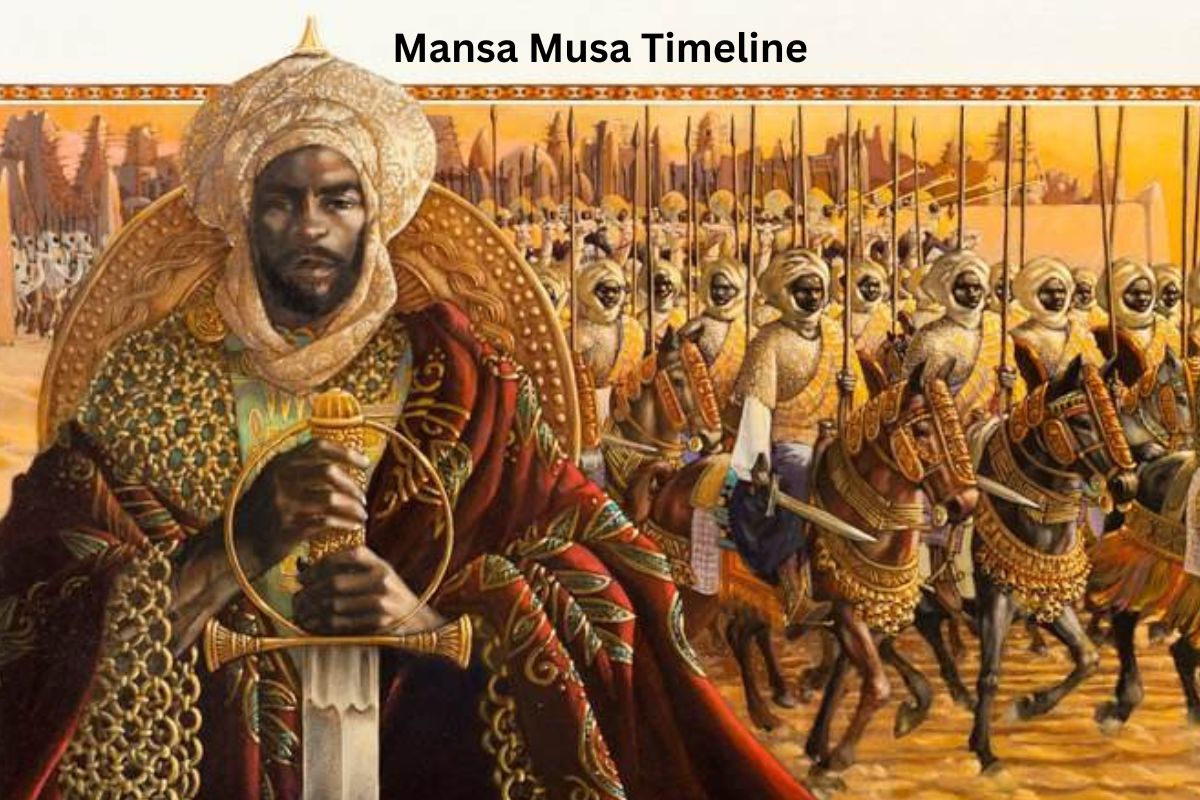Mansa Musa was a 14th-century ruler of the Mali Empire in West Africa, born in 1280 in Niani, Mali. He ascended to the throne in 1312, becoming the ninth ruler (Mansa) of the empire.
Mansa Musa is most renowned for his extravagant pilgrimage to Mecca in 1324-1325, during which he displayed immense wealth, distributing gold along the way.
This pilgrimage attracted global attention and established Mali’s reputation as one of the wealthiest kingdoms in the world.
After his pilgrimage, he embarked on significant construction projects in Mali, including the construction of the Djinguereber Mosque in Timbuktu.
Mansa Musa passed away in 1337, succeeded by his son, Maghan I. His legacy includes his contributions to Islamic culture, architecture, and education in West Africa, making him an iconic figure in African history.
| Year | Event |
|---|---|
| 1280 | Mansa Musa was born in Niani, Mali. |
| 1312 | Mansa Musa became the ninth ruler (Mansa) of the Mali Empire. |
| 1324-1325 | Mansa Musa’s famous pilgrimage to Mecca, showcasing his wealth. |
| 1325-1327 | Mansa Musa’s two-year journey, visiting North Africa, the Middle East, and Arabia. |
| 1332 | Mansa Musa’s construction projects in Mali, including Djinguereber Mosque. |
| 1337 | Mansa Musa’s death; succeeded by his son, Maghan I. |
Timeline of Mansa Musa
1280 – Mansa Musa was born in Niani, Mali
In the year 1280, Mansa Musa was born in the town of Niani, which was part of the Mali Empire. He was born into a prominent family, and his full name was Musa Keita I.
His birthplace, Niani, was a significant city in the Mali Empire, known for its wealth and cultural importance.
1312 – Mansa Musa became the ninth ruler (Mansa) of the Mali Empire
In 1312, Mansa Musa ascended to the throne of the Mali Empire, becoming the ninth ruler, commonly known as “Mansa.” His journey to the throne followed the death of his predecessor, Abu-Bakr II.
Also Read: Mansa Musa Accomplishments
This marked the beginning of his influential reign over the Mali Empire, a period that would see significant changes and events under his leadership.
1324-1325 – Mansa Musa’s famous pilgrimage to Mecca, showcasing his wealth
One of the most renowned events in Mansa Musa’s life was his pilgrimage to the holy city of Mecca, which took place from 1324 to 1325. This pilgrimage was a pivotal moment not only in his life but also in the history of West Africa.
Mansa Musa embarked on this pilgrimage with a vast entourage, including family members, officials, and servants. However, what made this pilgrimage particularly remarkable was the immense amount of gold and wealth he carried with him.
Also Read: Mansa Musa Facts
Mansa Musa’s procession through various cities on his way to Mecca, including Cairo, Egypt, was characterized by his generous distribution of gold and gifts to the people he encountered.
His extravagant displays of wealth left a lasting impression on those who witnessed them and contributed to the Mali Empire’s reputation as one of the richest and most prosperous kingdoms in the world at the time.
The impact of Mansa Musa’s pilgrimage extended beyond the African continent, as it played a significant role in shaping the world’s perception of West Africa and its wealth during the medieval period. This event also highlighted the Mali Empire’s position as a center of culture, trade, and scholarship during Mansa Musa’s rule.
1325-1327 – Mansa Musa’s two-year journey, visiting North Africa, the Middle East, and Arabia
In 1332, following his return from the famous pilgrimage to Mecca, Mansa Musa embarked on a series of ambitious construction projects within the Mali Empire. One of the most renowned constructions attributed to him is the Djinguereber Mosque in the city of Timbuktu.
This mosque is considered a masterpiece of Sudano-Sahelian architecture and remains a symbol of Mansa Musa’s commitment to promoting Islam and culture in his empire.
The Djinguereber Mosque is made of mudbrick and has a distinctive structure with three large towers. It served as a center for Islamic scholarship and education during its time and is still in use today, making it one of the oldest mosques in West Africa.
Mansa Musa’s patronage of such architectural marvels contributed to the cultural and religious richness of the Mali Empire.
1332 – Mansa Musa’s construction projects in Mali, including Djinguereber Mosque
In 1337, Mansa Musa passed away, marking the end of his remarkable reign as the ruler of the Mali Empire. After his death, his son, Maghan I, succeeded him as the new Mansa.
While Mansa Musa’s reign was marked by unprecedented wealth and cultural achievements, his son faced the challenges of maintaining the empire’s stability and prosperity in the years following his father’s rule.
Mansa Musa’s death, however, did not diminish his legacy. His pilgrimage, generosity, and contributions to architecture had left an indelible mark on the Mali Empire and the broader world’s perception of West Africa. His empire continued to be influential in trade, culture, and scholarship in the region for some time.
1337 – Mansa Musa’s death; succeeded by his son, Maghan I
Mansa Musa’s legacy extends far beyond his lifetime. He is remembered as one of the most famous and influential leaders in African history.
His pilgrimage to Mecca and the extravagant distribution of gold along the way made him a legendary figure and contributed to the world’s awareness of the wealth of West Africa during the medieval period.
Additionally, Mansa Musa’s support for Islamic culture and scholarship, as demonstrated by the construction of the Djinguereber Mosque and other educational institutions, helped to promote the spread of Islam in the region and fostered a climate of learning and intellectual exchange.
The Mali Empire, under his rule, reached its zenith and was recognized as a major player in trans-Saharan trade and diplomacy. Mansa Musa’s reign is often cited as a testament to the wealth, sophistication, and cultural achievements of West Africa during this period.
